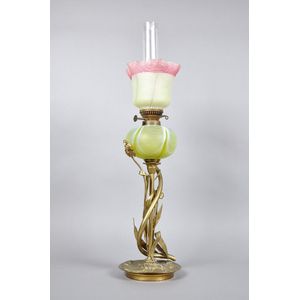Art Nouveau Nailsea Glass Kerosene Lamp with Matching Shade
You must be a subscriber, and be logged in to view price and dealer details.
Subscribe Now to view actual auction price for this item
When you subscribe, you have the option of setting the currency in which to display prices to $Au, $US, $NZ or Stg.
- Ormolu - Ormolu was popular with French craftsmen in the 18th and 19th century for ornamental fittings for furniture, clocks and other decorative items. True ormolu is gilt bronze, that is bronze that has been coated with gold using a mercury amalgam. Due to the health risks associated with using mercury, this method of creating ormolu was discontinued in France in the 1830s. A substitute was developed consisting of about 75% copper and 25% zinc, however it was inferior to the bronze version. It was often lacquered to prevent it tarnishing.
- Art Nouveau Period - The Art Nouveau period was a cultural movement that emerged in the late 19th century, and was characterized by its emphasis on natural forms, flowing lines, and a decorative, ornamental style. Art Nouveau was a reaction against the ornate and heavily stylized designs of the previous era, and sought to create a new, more organic aesthetic.
Art Nouveau was characterized by its use of sinuous, curving lines, as well as a focus on natural elements such as flowers, vines, and other organic shapes. Art Nouveau designers sought to create a total work of art, in which every element of a building or object was designed to be harmonious with the overall design.
Some of the most iconic examples of Art Nouveau design include the Paris Metro entrances designed by Hector Guimard, the works of the artist Alphonse Mucha, and the architecture of Victor Horta in Brussels.
The Art Nouveau period was at its peak between 1890 and 1910, but began to decline in popularity by the start of World War I. However, Art Nouveau remains an important influence on design and art to this day, and continues to be celebrated for its emphasis on natural forms and decorative style.
This item has been included into following indexes:
Visually similar items

Antique repousse rectangular sterling silver tray, marked for Chester 1904-5, 26.5 cm x 20.5 cm, approx 206 grams

18ct white gold tanzanite diamond earrings square cut Tanzanites set on an angle surrounded with diamonds to a straight diamond set bale, post and butterfly fittings. (new)

Takahashi, Hiroaki (1871-1945), 'Fuji From Mizukubo', woodblock in colours, 1936, with signature and red seal of artist lower left, Watanabe publisher's seal lower right. Height 25 cm. Width 37.5 cm

English hallmarked sterling silver George V dish having a plain oval body with shaped border & applied reeded edge, sitting on four cast scrolled shell form feet. Inscribed 'Connie & Jack From Cousins George & Andrew', Birmingham, 1911, maker Stewart Dawso
